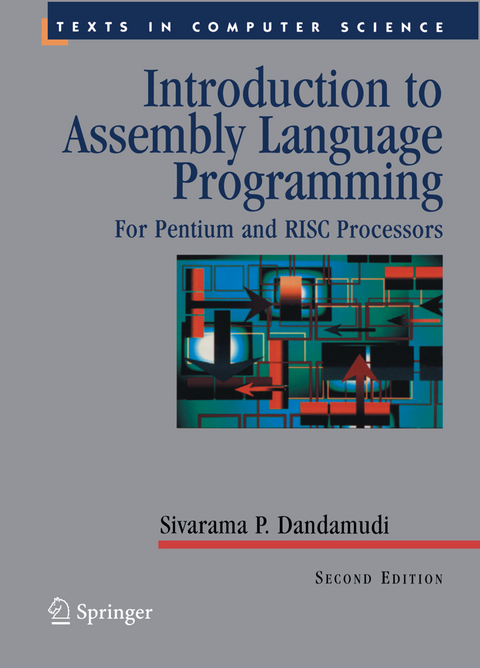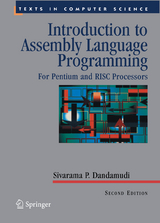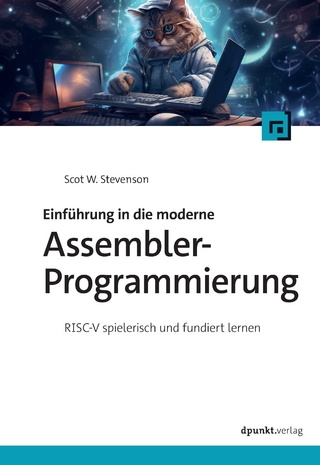Introduction to Assembly Language Programming
For Pentium and RISC Processors
Seiten
2004
|
2nd ed. 2005
Springer-Verlag New York Inc.
978-0-387-20636-3 (ISBN)
Springer-Verlag New York Inc.
978-0-387-20636-3 (ISBN)
Introduces the assembly language programming and its role in computer programming and design. This book covers the main features including stacks, addressing modes, arithmetic, selection and iteration, and bit manipulation. It also presents advanced topics including string processing, macros, and interfacing with higher-level languages such as C.
Assembly language continues to hold a core position in the programming world because of its similar structure to machine language and its very close links to underlying computer-processor architecture and design. These features allow for high processing speed, low memory demands, and the capacity to act directly on the system's hardware. This completely revised second edition of the highly successful Introduction to Assembly Language Programming introduces the reader to assembly language programming and its role in computer programming and design. The focus is on providing readers with a firm grasp of the main features of assembly programming, and how it can be used to improve a computer's performance. The revised edition covers a broad scope of subjects and adds valuable material on protected-mode Pentium programming, MIPS assembly language programming, and use of the NASM and SPIM assemblers for a Linux orientation. All of the language's main features are covered in depth. The book requires only some basic experience with a structured, high-level language.
Topics and Features: Introduces assembly language so that readers can benefit from learning its utility with both CISC and RISC processors [ NEW ].- Employs the freely available NASM assembler, which works with both Microsoft Windows and Linux operating systems [ NEW ].- Contains a revised chapter on "Basic Computer Organization" [ NEW].- Uses numerous examples, hands-on exercises, programming code analyses and challenges, and chapter summaries.- Incorporates full new chapters on recursion, protected-mode interrupt processing, and floating-point instructions [ NEW ].
Assembly language programming is part of several undergraduate curricula in computer science, computer engineering, and electrical engineering. In addition, this newly revised text/reference can be used as an ideal companion resource in a computer organization course or as a resource for professional courses.
Assembly language continues to hold a core position in the programming world because of its similar structure to machine language and its very close links to underlying computer-processor architecture and design. These features allow for high processing speed, low memory demands, and the capacity to act directly on the system's hardware. This completely revised second edition of the highly successful Introduction to Assembly Language Programming introduces the reader to assembly language programming and its role in computer programming and design. The focus is on providing readers with a firm grasp of the main features of assembly programming, and how it can be used to improve a computer's performance. The revised edition covers a broad scope of subjects and adds valuable material on protected-mode Pentium programming, MIPS assembly language programming, and use of the NASM and SPIM assemblers for a Linux orientation. All of the language's main features are covered in depth. The book requires only some basic experience with a structured, high-level language.
Topics and Features: Introduces assembly language so that readers can benefit from learning its utility with both CISC and RISC processors [ NEW ].- Employs the freely available NASM assembler, which works with both Microsoft Windows and Linux operating systems [ NEW ].- Contains a revised chapter on "Basic Computer Organization" [ NEW].- Uses numerous examples, hands-on exercises, programming code analyses and challenges, and chapter summaries.- Incorporates full new chapters on recursion, protected-mode interrupt processing, and floating-point instructions [ NEW ].
Assembly language programming is part of several undergraduate curricula in computer science, computer engineering, and electrical engineering. In addition, this newly revised text/reference can be used as an ideal companion resource in a computer organization course or as a resource for professional courses.
Overview.- Basic Computer Organization.- Pentium Assembly Language.- The Pentium Processor.- Overview of Assembly Language.- Procedures and the Stack.- Addressing Modes.- Arithmetic Flags and Instructions.- Selection and Iteration.- Logical and Bit Operations.- String Processing.- ASCII and BCD Arithmetic.- MIPS Assembly Language.- MIPS Processor.- MIPS Assembly Language.- Interrupt Processing.- Protected-Mode Interrupt Processing.- Real-Mode Interrupts.- Advanced Topics.- Recursion.- High-Level Language Interface.- Floating-Point Operations.
| Reihe/Serie | Texts in Computer Science |
|---|---|
| Zusatzinfo | XXIV, 692 p. |
| Verlagsort | New York, NY |
| Sprache | englisch |
| Maße | 178 x 235 mm |
| Themenwelt | Informatik ► Programmiersprachen / -werkzeuge ► Assembler |
| Mathematik / Informatik ► Informatik ► Software Entwicklung | |
| Informatik ► Weitere Themen ► Hardware | |
| ISBN-10 | 0-387-20636-1 / 0387206361 |
| ISBN-13 | 978-0-387-20636-3 / 9780387206363 |
| Zustand | Neuware |
| Informationen gemäß Produktsicherheitsverordnung (GPSR) | |
| Haben Sie eine Frage zum Produkt? |
Mehr entdecken
aus dem Bereich
aus dem Bereich
Buch | Softcover (2024)
dpunkt (Verlag)
CHF 51,65


